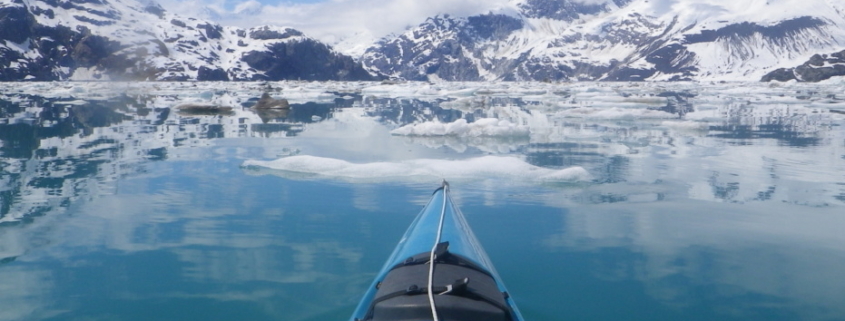Drowning to Live
 “Woman overboard in the icy swells of Resurrection Bay!”
“Woman overboard in the icy swells of Resurrection Bay!”
While it sounds like a newspaper headline heralding the tragic end of a life, it was actually an event that I willingly paid to do: plunge headfirst into the frigid waves of Resurrection Bay off Alaska’s Seward coast.
Okay, so it wasn’t really as ridiculous as it sounds. It really was a decision that I made in my right mind and one that strangely, I didn’t later regret.
It all began when a girlfriend of mine suggested that we take a weekend out, and go sea kayaking along the Alaskan coast. In addition to cruising around inlets and coves, she had arranged for a morning class to familiarize ourselves with the joys and dangers of sea kayaking. While I’ve paddled in a fair amount of locations, I’d never taken an actual course teaching maneuvers, navigation, survival, and rescue, so I thought this would be a great addition to my adventure and signed up.
At six o’clock on the morning of our trip, I met up with four other girls in a grocery store parking, and after we’d loaded all of our camping gear into my Suburban, we headed down the coast for a rainy, two-hour drive. After weaving in and out of mountain passes, hugging rocky cliffs that plunged into glacial silt, and scooting across grassy wetlands, the rain began to dissipate and we found ourselves in quaint, mystical Seward, Alaska.
Our class began teaching the basics of kayaking: differences between boat designs, stroke techniques, basics of navigation, and survival and distress procedures. “Securitae, Securitae, Securitae” for general announcements or notices of crossing large shipping lanes. “Ponpon, Ponpon, Ponpon” for non-life-threatening distress calls. “Mayday, Mayday, Mayday” for emergency calls of immediate threat to life.
All of the class seemed familiar and routine to me and I began to wonder if I should skip the class and join the rest of my group for the afternoon excursion. That’s when everything changed.
Our instructor began the water portion of the training; a lesson in self-rescue and other-rescue, depending if a person “tipped” in a single or tandem kayak. As our group had five persons and I was the most experienced, I was given the single kayak and the rest of the group was paired up into two tandem kayaks. Soon we were suited up in wetsuits heading across the rocky beach toward the gray, chilly waters of Resurrection Bay.
Unlike the ideal floats in my dreams, the sky was somewhat dark mirroring the intimidating waves swelling high: glacier-fed waters, clear and cold. It was here in this less-than-ideal environment that we were going to voluntarily plunge our bodies into the ocean.
Our instructors gave us the rundown of the varying steps required for the different kayak types, and we desperately committed them to memory, hoping that the shock of the water temperature and our imaginations of things deep didn’t cloud our thinking.
As we struggled against the waves to navigate toward a deep, vessel-free area of the bay, I began to question my sanity. I’d kayaked in many different places, in a variety of conditions and waters, without tragic events or even minor threats to my safety. Why did I think I needed to subject myself to this? I wasn’t an expert, but I certainly wasn’t a novice. Couldn’t I get along in the future, just doing what I’d always done? Did I have to purposefully capsize myself to prove I could do something I’d been doing for years?
As I was mentally finalizing my argument, my instructor told me I was to go first. Without realizing it, I had paddled into direct position and was perfectly placed to demonstrate my version of suicide by drowning.
I sat there with my feathered paddle in an static position, thinking, How does a person intentionally flip their boat? Doesn’t instinct keep us balanced and upright? I don’t think I can do this. Then, with a quick breath and a quicker prayer, I swung by body left into the chilly, 40 degree waves.
I was surprised how quickly the boat flipped, trapping me upside down in the water. Instinct took over and I quickly located and pulled the release tab, pushing myself downward into the water and out of the overturned boat. Within seconds, I popped up onto the surface, gasped for breath, and quickly located my boat and paddle. As I fought the waves and struggled to flip the vessel rightside up, I began mentally checking off the steps I’d stowed away in my brain. Return the boat topside up. Blow eight deep breaths into the paddle float, push it over one end of the paddle, and secure it three times with the strap. Lodge the unfettered end of the paddle through the kayak straps, perpendicular to the kayak, creating an outrigger effect to counterbalance and stabilize the vessel. Placing the majority of body weight on the extended paddle, slowly begin lifting body onto the twisting boat, remaining low to the surface of the kayak. Perform a belly crawl toward the back of the kayak, passing the opening, until one leg can enter backwards into the seat compartment. Insert the second leg into the compartment, and slowly rotate your body until you are seated right side up in the kayak. Secure and seal the kayak skirt, so the onslaught of waves will not add additional water into the overloaded boat. Quickly begin pumping water out of the vessel to stabilize the balance and prevent subsequent flips. Once the water is successfully removed, stow the pump and float back into their secure position and begin paddling to safety.
What seemed like torturous hours passed swiftly, and after I ran through each step I was amazed at the how quickly I found myself safely back inside my boat. I paddled through the water to my friends, shivered in the wind, and watched them take their turn. As each person bravely plunged into the cold water, I watched the varied reactions and instincts take hold. Some were shocked by the icy, swift waves, while others immediately panicked with the reality of drowning and thoughts of creatures hovering deep. Some mechanically ran through the steps and instinctively began rescuing their partner. Whatever the initial reaction, we all overcame our fear and made it through the challenge, rising from the water, cold, wet, and liberated.
It wasn’t until we began heading back for the shore that I suddenly realized what an amazing thrill and invaluable experience I had just participated in. Though the waters were still choppy and the threatening sky hovered overhead, I suddenly saw the beautiful, fog-draped mountains, an otter floating on his back, seagulls and eagles jockeying for fish nearby; all scenes I’d missed in my earlier pass through these grey waters.
Although I was somewhat experienced in the art of sea kayaking, there was something different about my stroke, something new about the way in which I maneuvered my vessel. I was free.
I had placed myself in one of the most precarious positions a sea kayaker can encounter, purposefully tipped into the ocean, and successfully re-entered my boat all by myself. I had lived my worst case scenario and survived.
I felt fully alive.


